In Joy, Peace and Love
Szöveg: hm.gov.hu | 2010. szeptember 28. 12:18More than 200 participants made a pilgrimage organized by the MoD Catholic Military Chaplaincy on September 25. The International Military Pilgrimage and Family Day were held at the Roman Catholic shrine church of Budakeszi-Makkosmária where Army Bishop Dr. László Bíró celebrated Mass.
The MoD Catholic Military Chaplaincy organized the International Military Pilgrimage for the 16th time and the Family Day for the fourth time. The events are held each year on the weekend closest to September 25, the Day of the Blessed Virgin Mary Deliverer of Captives.
MoD Chief of Staff Dr. Gábor Szarka welcomed the soldiers and their family members inside the shrine church. He said that the first pilgrimage had been organized in 1994 at Búcsúszentlászló on then Catholic Army Bishop Gáspár Ladocsi’s initiative, but the venue has changed since, so that for some years now the participants of the pilgrimage regularly come together in the church of Makkosmária. “We are here today to make sure that families can rejoice in each other’s presence and that we can live in love and peace", the MoD Chief of Staff pointed out.
“How can we square our faith – which is based on the respect for human life – with the military vocation, the carrying and potential use of arms?" This is the question we ask ourselves on many occasions. In my opinion, we, soldiers, who know what life, death and service mean, are the ones who can respect life because we know what it is like when it comes to an end. This is how we can square the military vocation with our Catholic faith, and this is the reason for our being here today", Dr. Gábor Szarka said in his welcome speech.
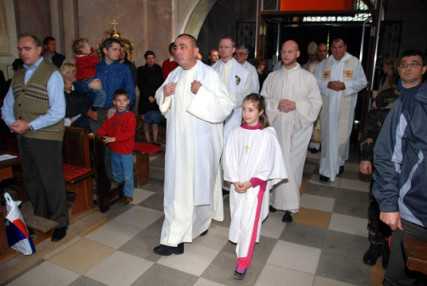
In what followed, Catholic Army Bishop Dr. László Bíró blessed the enamel work made by artist Gábor Rácz for the Catholic Military Chaplaincy. The enamel picture depicting the Blessed Virgin Mary Delivered of Captives will be placed in the chapel of the Military Chaplaincy because this chapel had been consecrated in honor of the Blessed Virgin Mary Deliverer of Captives.
Army Bishop Dr. László Bíró celebrated the Roman Catholic Mass. “What do we do in worshipping the Blessed Virgin Mary Deliverer of Captives?", the Bishop asked in his sermon. “The cult of the Blessed Virgin Mary Deliverer of Captives has a message, which is the message of a “You-centered" way of thinking in an egoist and individualist world. The cult conveys a message from God to the Church, the society and the families", the Bishop said, adding that this cult at once conveys a certain image of God to the people, the image of a God who wants to set human beings free. “The idea of delivering the captives is about the delivering mission of the Church, since the Church leads man into freedom", László Bíró noted.
At the end of the Mass the Catholic Army Bishop confirmed a young man, Kornél Horváth, who wants to become a military chaplain himself. The Catholic confirmation service was the second stage in the process leading to his aim.
After the Mass the Veszprém Air Force Band gave a concert in the churchyard, playing the St. Stephen March by Péter Dávid and several WWI army songs and arrangements of pop hits to entertain the participants of the pilgrimage. Farther off a playhouse for children was set up where they could try out sewing among other things.
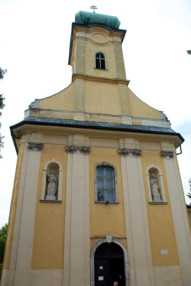
Upon hearing about these developments Ádám Acsádi, the Bishop of Veszprém permitted the public worship of the icon. Afterwards a small chapel was built around the picture from the donations and two hermits living in the neighborhood were appointed as caretakers.
The Trinitarian Order of Óbuda built a single-steeple church and a small cloister at the popular place of pilgrimage. This order, which is known as “The Order of the Blessed Virgin Mary Deliverer of Captives named after the Trinity", was working to ransom the Christians who had been taken into captivity throughout the fight against the Ottoman rule across Southern Europe. The monks were collecting money and in many cases exchanged themselves for some prisoner of war. Ignác Koller, the Bishop of Veszprém consecrated the church in 1768 in the presence of 10,000+ pilgrims. The trunk of the oak-tree was placed together with the icon inside the church.
When Emperor Joseph II disbanded the order of the deliverers of captives in 1784, the flourishing shrine of Mary was closed and the icon and the trunk were brought to the parish church of Budakeszi. The cloister and the church went to secular organizations and fell into ruin in some decades. During World War I Budakeszi Parson József Miller bought the ruins of the church with the cloister back for the Church. Some years before World War II the priests of the Order of Friar Servants of Mary resumed celebrating Mass on Sundays and the holidays of Mary in the small ruined chapel. During and after the war a growing number of people came here to pray for their relatives who had been taken prisoners of war.
The worship of the Blessed Virgin Mary Deliverer of Captives was beginning to take shape here. Thanks to the congregation’s donations and efforts, the Servites were able to build the present church between 1938 and 1947, which was consecrated by Lajos Shvoy, the Bishop of Székesfehérvár in 1950. The trunk and the icon were placed at this site again. In 1950 Jesuit Parson Father P. János Tamás replaced the Servites who had been forced to leave due to the disbandment of religious orders. He was running the shrine church for 33 years. Renovated in 1964, the building is currently being run by the Dominican Order. Although the war ended a long time ago, Christians are still visiting the shrine church to pray for the “captives", namely for those addicted to drugs, alcohol, carnal pleasures, gambling and for all other kinds of addicts.
,
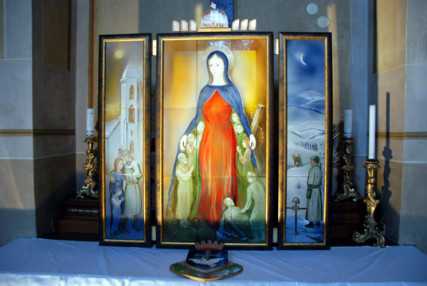
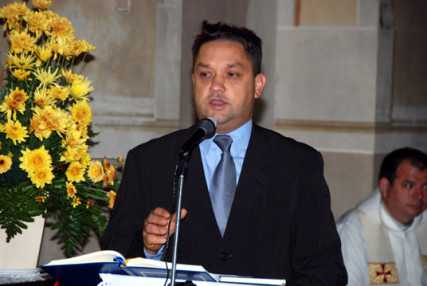
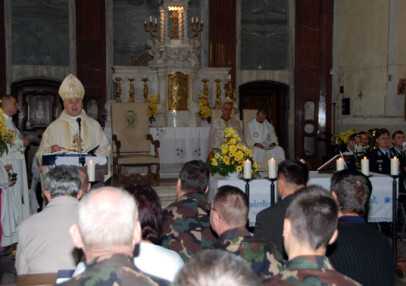

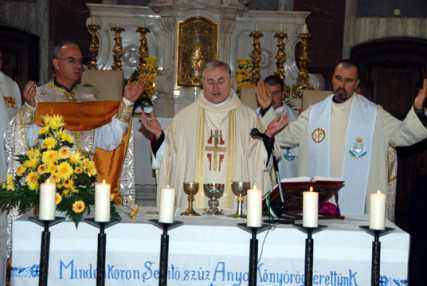
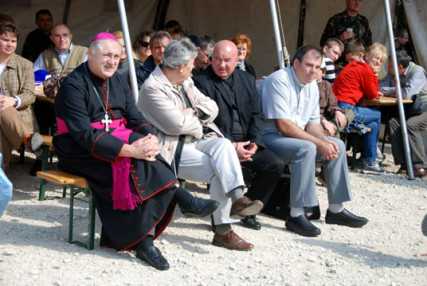
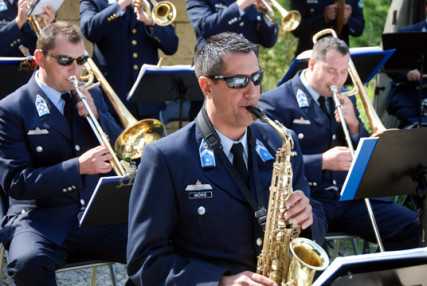
Text and photo: László Szûcs